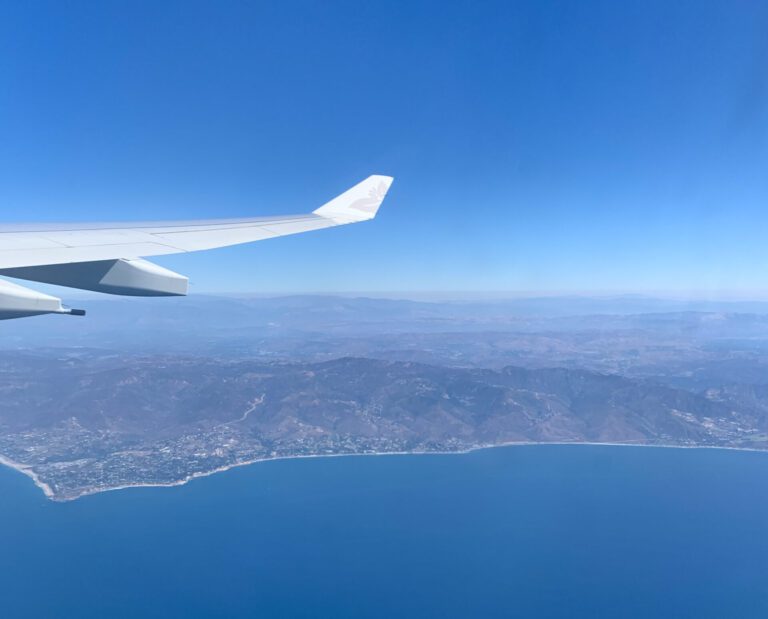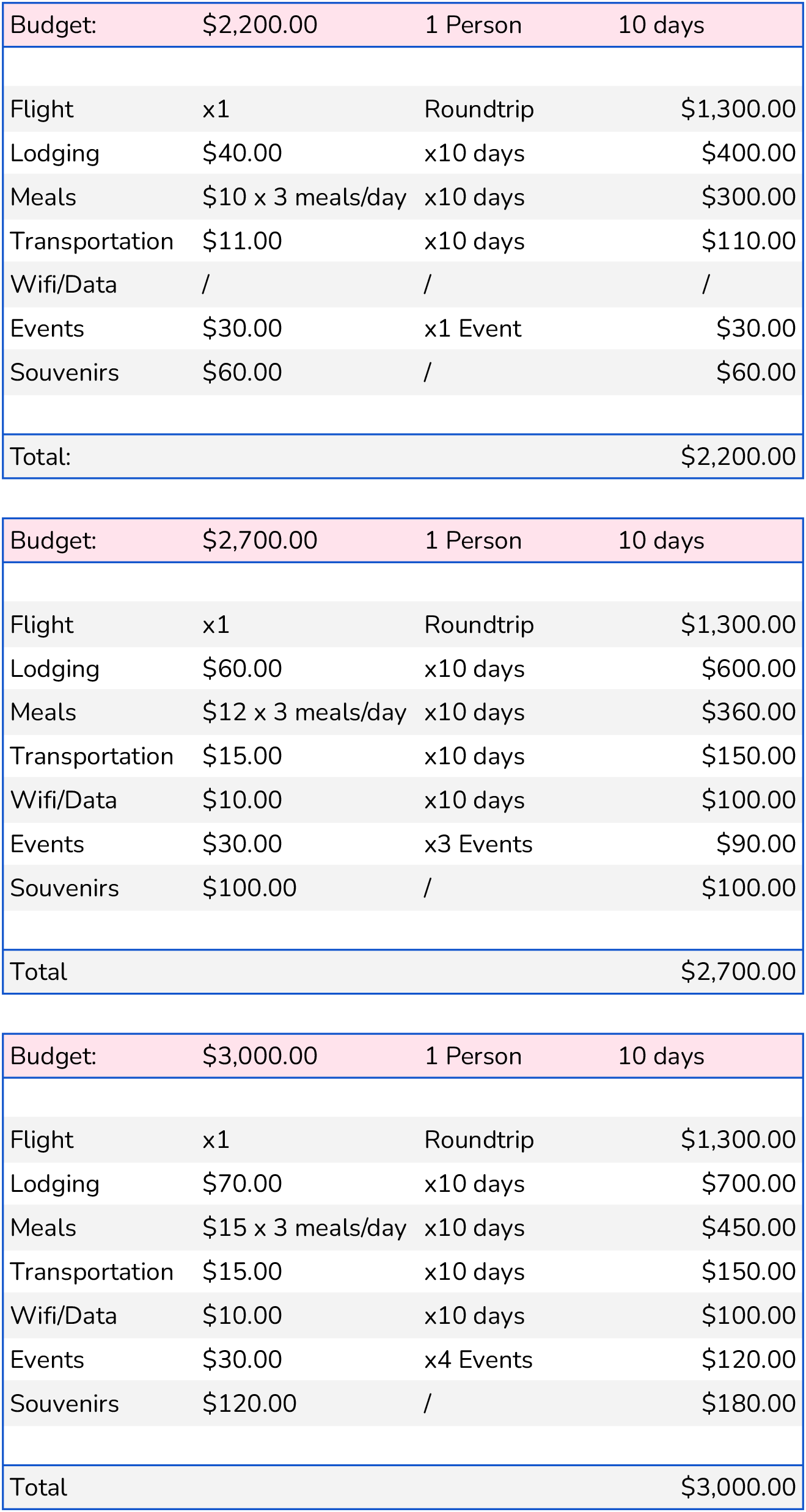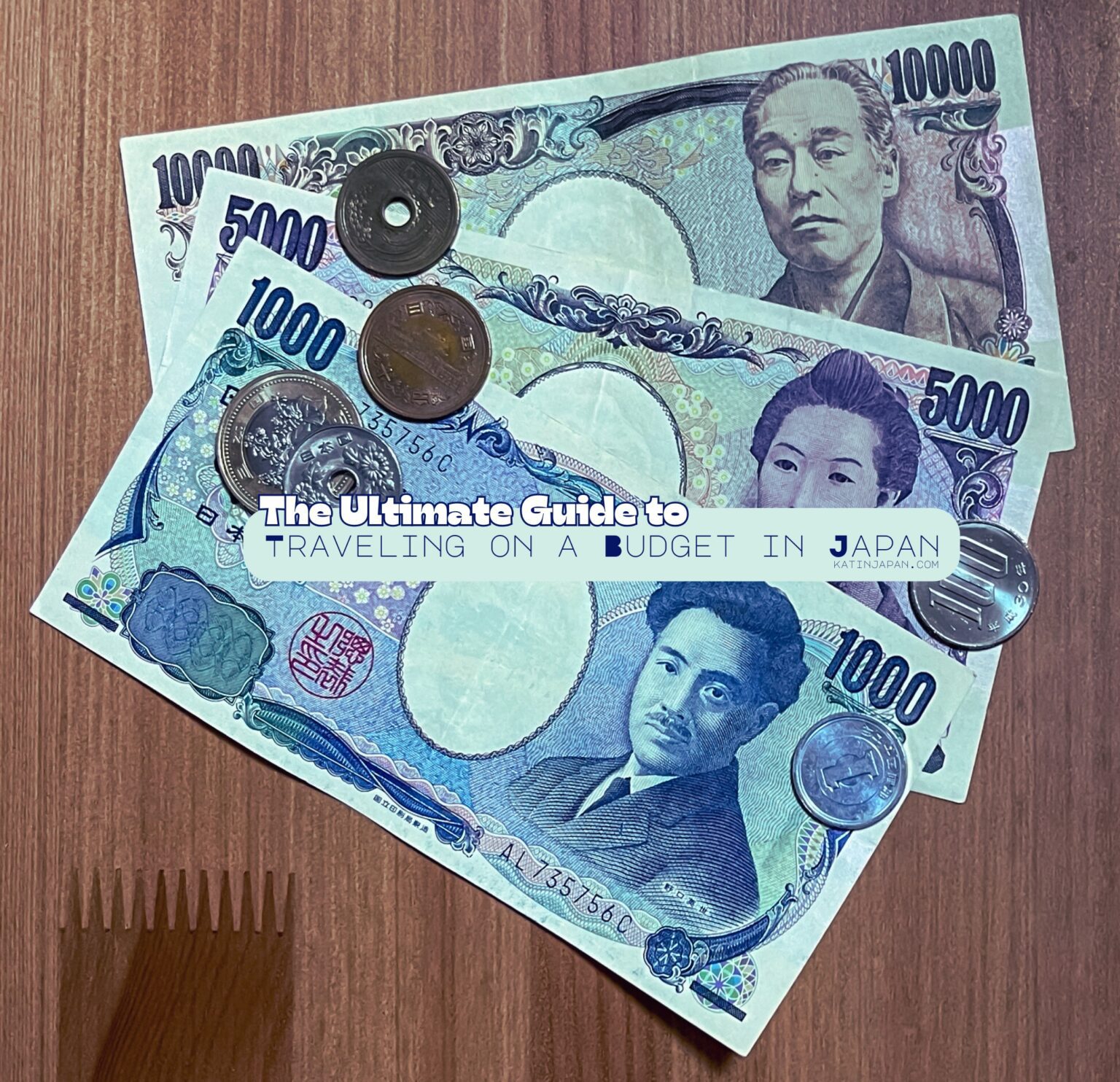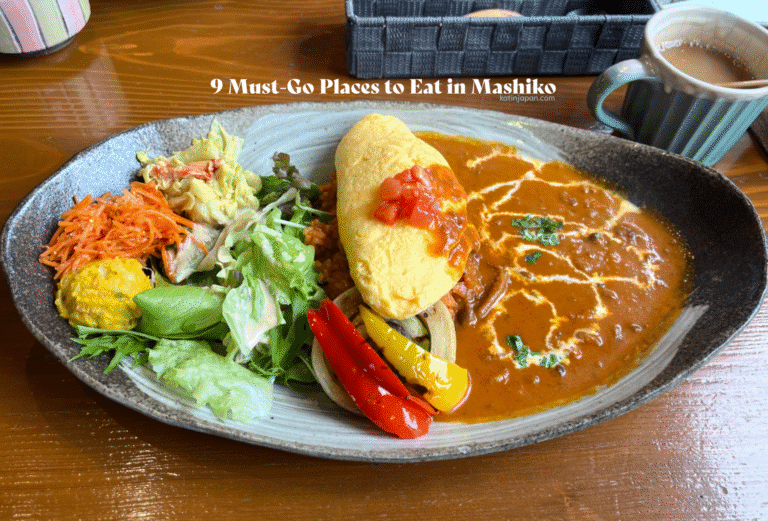Is it possible to travel to Japan on a budget? How much money do you really need? Traveling to Japan on a budget may seem impossible, but it’s quite the opposite!
In fact, Japan can be extremely budget-friendly if you know a few tips and tricks. While I’ll mainly be addressing tourists from the west, these hacks can be used no matter where you’re coming from.
This is The Ultimate Traveling on a Budget list of ways to get the most bang for your buck and enjoy the sights in Japan.
And if you just want to see the cost-breakdowns, check ’em out below.
Finding Cheap Flights

Traveling, eating, and shopping within the country can be relatively affordable. Getting there is the cost-prohibitive part. If you’ve ever wondered how to travel Japan on a budget, flights are probably the first concern that come to mind.
In my experience, an affordable round-trip flight from Japan to California costs around $1300. In recent years that figure has expanded to up to $2000 depending on the season and airline’s situation.
When my husband and I flew back to the US for our August 2023 wedding, for example, flights costed around $1700 per person round-trip. That’s a hefty fee.
But things are always changing.
As of mid November, 2024, flights are inexplicably cheap. Yes, cheap! There are many factors as to why. As this Medium article puts it, factors like seasons, exchange rates, and travel deals all play a major role.
If you can be flexible and open-minded about your travel plans, then you can probably find a flight in your price range.
Look for Out of Season Flights
One way to get a good deal on flights is by traveling out of season.
In Japan, the most popular times to visit are Spring and Summer. The cherry blossom season and festivals are extremely popular during these times. Plus, they align with school vacations in the West, making them very popular, but also quite crowded.
If you want to visit Japan during the off-season, consider Fall and Winter. These are heavily underrated seasons for touring Japan.
You can see gorgeous illumination, enjoy the New Year’s festivities, or just frolic in the cool weather. You can also enjoy skiing and cafe-hopping if you’re so inclined.
Fly not just on off-season, but on off-days. Utilize the calendar function on travel sites to see the cheapest days to fly. Usually, this means flying on a weekday and/or taking red-eye flights.
Fly into Narita
Narita International Airport (NRT) is further than Haneda (HND) from Tokyo. If you fly into Narita, you can often find cheaper flights.
However this cost can be offset if you choose to take a taxi to Tokyo instead of cheaper methods like bus or train.
Layover in other Countries
Buying flights with layovers has always been a great way to reduce flight costs. But be cautious – depending on the layover, you may not always be getting the best deal.
Ideally, you should look for layovers in countries like Taiwan, Vietnam, and other nearby countries. You can even stay there for a day or two. Usually, flights with layovers in these countries cost less than a direct flight to Japan.
If you can, avoid taking flights with more than one layover in different countries. Depending on the airport you may need to go through security again, so factor this into your layover times.
When we went on a flight from Japan to the US with a layover in Manila, we almost missed our flight due to the tight timing.

Use Flight Scanners to get the Best Deals
While popular travel sites like Expedia exist, you can use sites like Skyscanner and Momondo to get better deals.
(Not sponsored, but highly recommended by my good friend and budget-travel expert, Jace).
By cross-referencing these sites you can find the most affordable flights available across a variety of airlines.
Then check the airline’s own website to confirm that you’re getting the best price.
Flight TL;DR
- Use flight scanners like Skyscanner or Momondo for deals.
- Travel out of season.
- Take flights on weekdays or take red-eyes.
- Try flying into Narita.
- Layover in neighboring countries.
Choose a Hotel Wisely
Hotels in the smack-dab of Tokyo can be more expensive, but you can also opt for hostels or budget-friendly business hotels.
I’ve divided Japanese hotels into the following 5 categories, with number 1 being the cheapest, and 5 being the most expensive.
Depending on your budget, options 2 and 3 have the best cost performance (コスパ kosupa).
1. Capsule Hotels (+ Honorable Mention to Love Hotels)
By now just about everyone has heard about capsule hotels. Popularized in the 80’s, these efficient little pods are ideal for businessmen who need a cheap place to sleep for a night.
In fact, many capsule hotels are only for men. However, their recent rise in popularity has led to more all-gender and all-women hotels.
For example, you can stay as cheaply as ¥3500 (~$23) per night. Typical costs range from about ¥3500-¥6000.
And okay, we’ve all heard about love hotels and the wacky things in them.
I’m all for trying them out for fun, but if you’re looking for accommodation, you should check out the next few options.
Love hotels just aren’t made to be used as tourist stays, and likely won’t have the luggage or staff you need. That said, they are pretty cheap – they cost about the same as capsule hotels.
2. Hostels
In Japan, hostels are fairly common in cities like Tokyo. Inexpensive, but usually clean and safe, these are a great budget option.
Many hostels, like Nui Bar & Hostel or Wise Owls Hostel, operate as bars or cafes during the day to offset costs.
You essentially share your sleeping space with other tourists, and there are oftentimes spaces like communal kitchens or lounges. Hostels are great if you’re traveling solo or enjoy talking to strangers.
3. Business Hotels
These are your run-of-the-mill hotels. Slightly above what I would call a motel, these business hotels are usually clean, well-run, and include some type of Japanese or continental breakfast (usually via a voucher).
I’m a fan of these hotels, to be honest. They’re not too expensive, but they have all the amenities of a normal hotel. Including holding your luggage before your check-in time.
These are usually chain hotels like Super Hotel, APA, Toyoko Inn, etc.
You can generally trust that even low-rated business hotels like these have a pretty good reputation.
And if you plan on hitting the town more than staying in your hotel room, these are perfect places to leave your luggage, and then come back to collapse into bed.
4. Ryokans and Hotels with Onsen
Ryokans and hotels with onsen are often family-oriented.
Ryokan are of course Japanese-style inns that feature in-house meals and Japanese-style rooms. Some have onsen attached, while others may be near a public bathhouse.
Hotels with onsen like Hotel Sunshine in Kinugawa are popular among Japanese tourists. They’re hotels with features like built-in cafes, arcades, buffets, and of course, onsen.
If you’ve ever been to a hotel in Las Vegas, these feel similar– minus the smoke and gambling. Or picture the hotel in Super Mario Sunshine.
Kids and adults alike will walk around in the provided yukata, and enjoy playing table tennis or enjoying a meal.

5. Luxury Hotels
You can find some Ryokans and leisure hotels at great prices. If you have a Japanese phone number, you can even try booking through Rakuten travel or other Japanese sites for cheaper prices.
For example, we stayed at Besshonuma Heritage Hotel for about ¥6000 ($40) per person, per night. Granted, you had to use the public baths since the rooms did not come with a private shower.
Other Ryokans and hotels like those in Kinugawa can cost upwards of ¥15000 per person. However, they also boast more facilities.
While Ryokans can fall into this category, I’ll be addressing mainly Western-style luxury hotels in this section. And like western accommodations, these hotels usually come with lavishly decorated spaces, welcoming staff, and comfy beds.


If you want luxurious hotels like the Sendai Royal Hotel or Fuji Gotemba Rembrandt, you’ll have to shell out more for the caché.
If you want luxurious hotels like the Sendai Royal Hotel or Fuji Gotemba Rembrandt, you’ll have to shell out more for the caché. Not to mention dining at luxury hotels will also cost a pretty penny.
You’re looking at anywhere from ¥20000-50000+ per person, per night at some of these ritzy places. If you have money for the glitz and glam, go for it. But if you’re budgeting it out, I’d save your money for experiences and food while in Japan.
Hotel TL;DR
- The best cost-performance for price and comfort are hostels.
- They cost around ¥3000-¥7000, and are relatively safe and comfy.
- While business hotels are always a good fall-back, hostels in Japan are clean and safe. They’re also easier to book than capsule hotels for foreigners.
Pack Light
This advice works for any travel. Even if you get 2 checked bags with an international flight, packing less on purpose can serve you well. Here’s why.
If you pack only a small piece of luggage like a carry-on, you can avoid paying for services like luggage forwarding or unnecessary taxi trips.
And, if you plan to spend most of your extra cash on souvenirs, you can use this hack:
First, pack your small luggage with everything you plan to bring.
Second, close it up and nest it inside your larger luggage. This will be your checked bag.
This makes it easier to carry around Japan, instead of dragging two pieces of luggage.
Now, when you get to Japan and need space for souvenirs, you can use the larger luggage without having to buy a new one.

At the end of your trip, when you check your bags, you’ll be able to check them for free. And you’ll still have space to bring a backpack or carry-on!
Plus, if you need a handy list of what-to-bring to Japan, check out my Quintessential Japan Packing List!
Expenses in Japan
Once you’re in the country, most things aren’t actually that expensive. Food is really affordable, and public transit is efficient. But there are a couple of things to keep in mind.
Pocket Wifi vs SIM Cards
To travel in Japan, you’ll probably want to connect to data. You can of course set up an international data plan with your existing phone company, but people often opt for a separate SIM card or wifi puck.
Matcha JP has an article with some comparisons on this topic.
Generally, wifi pucks can cost under ¥1000 a day depending on their data capacity.
SIM Cards can run you about ¥4000-¥10000 depending on your length of stay and data capacity. Some also come with calling and texting plans. The brand Mobal comes to mind as having eSIMs as well.
Going No-SIM
If you’re a confident solo traveler, know some Japanese, or have been to Japan before, you can also attempt going without wifi or a SIM card.
You can utilize Tokyo Free Wifi, which is available at various spots throughout Tokyo. Just sign up with an email, and connect to hotspots automatically.
Google Maps has a feature where you can pre-download an area onto your phone for offline use. You can take advantage of this while traveling and avoid using your data.
Even better, if you add a point of interest to your ‘saved’ places in Google Maps, you can route to it without a connection. I recommend adding any places you want to go to before leaving your accommodation. And add your lodging to your list, too!
Travel Costs
Transportation costs can add up quickly. Do you research and plan your trip for specific areas to reduce backtracking and incurring extra costs.
Plan your Routes
I also recommend avoiding taxis if you’re on a tight budget. Taxi rides can easily get up to the ¥5000-¥10000 range per trip, especially in Tokyo.
If you can manage the insane amount of walking in Japan, then you can also avoid unnecessary train fees. Unless you’re going from one ward of Tokyo to another, you don’t need to take a train.
For example, Ueno to Asakusa is walkable. Ueno to Shinjuku will be better by train.

Though the public transport in Japan is excellent, it can cost ¥180-¥324 a ride depending on the distance and train type. I recommend planning each day of your trip around specific areas to avoid wasting money on unecessary train rides.
You can use the Pasmo or Suica e-wallet cards to get a slight discount on their respective lines. Tokyo Metro uses Pasmo, and JR Lines use Suica. If you know what trains you’ll be taking, you can pick one.
Or you can stick to the JR Welcome Suica which is available at the airport.
Keep an Eye out for Travel Passes
Some areas like Hakone in Japan have their very own travel passes.
Hakone’s Free Pass costs ¥6100 ($40), and gives you unlimited rides on their local transportation, and discounts if you come from Shinjuku.
Plus it provides discounts on facilities and events in the area like the Hakone Craft House and many others.
This article by Japan-Guide has a crazily comprehensive list of other travel passes by region.
Should you get a JR Rail Pass?
Well, considering they’re ¥50,000 ($330) as of December 2024, I would only get it if you already plan to travel all around Japan.
If you want to see Tokyo and Kyoto, it’ll probably be a wash. You can get a one-way ticket from Tokyo to Kyoto for about ¥12000-¥16000.
But if you plan to fly into Tokyo and out of Kyoto, then you won’t need a return Shinkansen ticket.
Overall, staying in just one area is the cheapest way to visit Japan. But if you can spare cash for the Shinkansen ticket fee, you could visit Kyoto and Tokyo.
Food and Event Costs
Meals usually cost under ¥1000 ($7), but popular restaurants and touristy areas are more expensive. Choose your eats wisely and you can easily stay in-budget.
If you’re looking for a nice meal, you can still eat delicious food for under ¥1500 and sometimes for under ¥900! You don’t have to eat at the most expensive places to get the best value in food.
Avoid High-Cost Tourist Traps
This is good advice for any trip: try to avoid tourist traps when possible.
Some events, exhibitions, and restaurants will naturally be unavoidable if you want to enjoy your trip, but be alert for scams.
Don’t follow people dressed in swanky clothing or maid costumes into bars or cafes as a rule. You’ll get ripped off.
Check signage before walking into restaurants for information on cover charges. Use your phone’s translate feature when possible to help. You can pre-download languages too.
If you end up in a restaurant that you don’t vibe with, just excuse yourself and leave before you order.
If you absolutely must go to that one cafe, do your research and plan to save some cash for it.
If you’re confident in your Japanese skills you can avoid establishments that boast English support, since many of them come with a higher cost. For example, a haircut at an English-speaking salon can cost double that of a standard haircut at a regular salon.
And in big cities like Tokyo and Kyoto, many areas will already have English accommodation, so don’t worry too much.
Book Early and Reserve in Advance
There are so many delicious spots and things to do in Tokyo and Japan in general that won’t break the bank. Average people aren’t spending $20+ on each meal. A simple meal usually costs under ¥1000 yen, and sometimes even less.
This trick may be obvious, but when in Japan, eat Japanese food!
Japanese food is cheaper almost every time. Unless you’re booking an omakase sushi dinner, going for ramen or conveyor belt sushi won’t break the bank.
Or you can try Japanese set meal (定食 teishoku) restaurants like Yayoi or Ootoya. Even a convenience store (コンビニ konbini) dinner can be fun and satisfying.
Of course if you plan some nice wagyu or omakase dinners while traveling, that’s perfectly fine too. But generally, Japanese style is the most affordable when it comes to your average dining experience.

By booking early, you can sometimes get special deals on restaurants and bars you want to visit.
By using resources like tabelog.com, gurunavi.com, or hotpepper.jp, you can make reservations online with discounts and offers (though you may need a Japanese phone number).
If these avenues don’t work, you can use travel sites like tripadvisor.com to book from abroad. (Not sponsored)
For example, I have made izakaya and dinner reservations at a discount by choosing a course meal ahead of time. Sometimes you can even
And of course, your seats are saved so you don’t have to worry about it being too busy.

If you have an eye on an extremely popular cafe or museum, always try to book in advance.
Things like the Ghibli Museum, Pokemon Cafe, Kirby Cafe, etc. sell out at lightspeed. And they are only bookable 1 month in advance.
If you don’t book at the exact date and time it becomes available, you’ll be out of luck. So set an alert for yourself to book on time.
Look for Free Experiences
Check out free things to do in Tokyo. You don’t always need to pay for experiences to enjoy Japan.
Instead of paying to go up Skytree, you can see the city skyline from the Tokyo Metropolitan Building
You can go on a mountain hike or walk through Ueno Park. There are often free public concerts and events going on there.
Or just get lost in the scenery and atmosphere of Tokyo.
I love seeing the Illumination at night in Winter, and sakura blooms in Spring are free to admire in many areas.
Plus, you can check out the many shrines and temples in Japan. Some have special areas that are accessible for a small fee, but generally you can just walk in and enjoy the grand torii gates and solemn buddhist works.

Be Smart about Exchange Rates
If you’re living in the US for example, the yen to dollar ratio is in America’s favor (2024). This is great if you plan on visiting Japan since you essentially get a discount on everything.
Check exchange rates often as you plan your trip. If they look favorable, try to order cash ahead of time. Banks in the US can take a couple of weeks to receive your foreign currency order.
While Japan has pretty good exchange rates at their airports, it’s usually better to order foreign money ahead of time.

You can utilize tax-free options at check-out in major malls, drug stores, and many souvenir shops. Just show your passport at the tax-free window or counter in stores like Don Quijote or major malls and drugstores. Even some smaller shops will honor this.
Prices mentioned at the time of publishing this blog may vary as time goes on. Since exchange rates fluctuate, just keep an eye on things as you plan your trip.
And if you’re planning your Japan trip from a country with less favorable exchange rates, try to order yen as it becomes more favorable and acquire it gradually as you plan for your trip.
Avoid Foreign Transaction Fees
And one more important tip: if you use a debit or credit card in Japan, make sure it doesn’t have any foreign transaction fees!
These fees can ding you $5, if not more, for each transaction.
From my experience banks like CapitalOne, Charles Schwab, Apple, and many others don’t have foreign transaction fees on many of their cards.
Credit cards are more likely to be fee-less than debit cards.
If you absolutely must use a card with a foreign transaction fee, use a debit or atm card to withdraw money directly at an atm. Seven-Eleven and other convenience stores often offer withdrawals from foreign banks.
That way you can minimize your fee to one transaction instead of every time you make a purchase.
Example Cost Breakdowns
If you’re like me, you like a breakdown. I’ve made 3 versions of a 10-day solo trip for three different budgets.
These are just general guidelines, but you can adjust them to your own situation.

So, you don’t have to break the bank just to go to Japan. I’ll admit, the flight is the priciest thing. But once you get here, costs truly are affordable for tourism.
And if you want to know some of the things you can do in Tokyo while you’re planning your trip, check out my 7-Must go Places in Ginza and Best 10 Things to Do in Asakusa!





Hello.
I’m new here 🙂